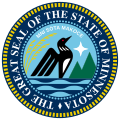#0excludeGlossary
Minnesota (/ˌmɪnəˈsoʊtə/ ⓘ MIN-ə-SOH-tə) is a state in the Upper Midwestern region of the United States. It is bordered by the Canadian provinces of Manitoba and Ontario to the north and east and by the U.S. states of Wisconsin to the east, Iowa to the south, and North Dakota and South Dakota to the west. The northeast corner has a water boundary with Michigan. It is the 12th-largest U.S. state in area and the 22nd-most populous, with about 5.8 million residents. Minnesota is known as the "Land of 10,000 Lakes"; it has 14,420 bodies of fresh water covering at least ten acres each. Roughly a third of the state is forested. Much of the remainder is prairie and farmland. More than 60% of Minnesotans (about 3.71 million) live in the Minneapolis–Saint Paul metropolitan area, known as the "Twin Cities", which is Minnesota's main political, economic, and cultural hub and the 16th-largest metropolitan area in the U.S. Other minor metropolitan and micropolitan statistical areas include Duluth, Mankato, Moorhead, Rochester, and St. Cloud.
Minnesota | |
|---|---|
| Nicknames: North Star State; Gopher State; Land of 10,000 Lakes; Land of Sky Blue Waters | |
| Motto: L'Étoile du Nord (French: The Star of the North) | |
| Anthem: "Hail! Minnesota" | |
 Location of Minnesota within the United States | |
| Country | United States |
| Before statehood | Minnesota Territory |
| Admitted to the Union | May 11, 1858 (32nd) |
| Capital | Saint Paul |
| Largest city | Minneapolis |
| Largest county or equivalent | Hennepin |
| Largest metro and urban areas | Minneapolis–Saint Paul |
| Government | |
| • Governor | Tim Walz (DFL) |
| • Lieutenant Governor | Peggy Flanagan (DFL) |
| Legislature | Legislature |
| • Upper house | Senate |
| • Lower house | House of Representatives |
| Judiciary | Minnesota Supreme Court |
| U.S. senators | Amy Klobuchar (DFL) Tina Smith (DFL) |
| U.S. House delegation | 4 Democrats 4 Republicans (list) |
| Area | |
• Total | 86,936 sq mi (225,163 km2) |
| • Land | 79,627 sq mi (206,232 km2) |
| • Water | 7,310 sq mi (18,930 km2) 8.40% |
| • Rank | 12th |
| Dimensions | |
| • Length | 400 mi (640 km) |
| • Width | 200–350 mi (320–560 km) |
| Elevation | 1,210 ft (370 m) |
| Highest elevation | 2,300 ft (701 m) |
| Lowest elevation | 600 ft (183 m) |
| Population (2024) | |
• Total | |
| • Rank | 22nd |
| • Density | 69/sq mi (26.6/km2) |
| • Rank | 36th (2020 census) |
| • Median household income | $85,100 (2023) |
| • Income rank | 13th |
| Demonym | Minnesotan |
| Language | |
| • Official language | none |
| • Spoken language | |
| Time zone | UTC– 06:00 (Central) |
| • Summer (DST) | UTC– 05:00 (CDT) |
| USPS abbreviation | MN |
| ISO 3166 code | US-MN |
| Traditional abbreviation | Minn. |
| Latitude | 43° 30′ N to 49° 23′ N |
| Longitude | 89° 29′ W to 97° 14′ W |
| Website | mn |
seat, Capital.Minnesota, which derives its name from the Dakota language, has been inhabited by various Native Americans since the Woodland period of the 11th century BCE. Between roughly 200 and 500 CE, two areas of the indigenous Hopewell tradition emerged: the Laurel complex in the north, and Trempealeau Hopewell in the Mississippi River Valley in the south. The Upper Mississippian culture, consisting of the Oneota people and other Siouan speakers, emerged around 1000 CE and lasted through the arrival of Europeans in the 17th century. French explorers and missionaries were the earliest Europeans to enter the region, encountering the Dakota, Ojibwe, and various Anishinaabe tribes. Much of what is now Minnesota formed part of the vast French holding of Louisiana, which the United States purchased in 1803. After several territorial reorganizations, the Minnesota Territory was admitted to the Union as the 32nd state in 1858. Minnesota's official motto, L'Étoile du Nord ("The Star of the North"), is the only state motto in French. This phrase was adopted shortly after statehood and reflects both the state's early French explorers and its position as the northernmost state in the contiguous U.S.
As part of the American frontier, Minnesota attracted settlers and homesteaders from across the country. Its growth was initially based on timber, agriculture, and railroad construction. Into the early 20th century, European immigrants arrived in significant numbers, particularly from Scandinavia, Germany, and Central Europe. Many were linked to the failed revolutions of 1848, which partly influenced the state's development as a center of labor and social activism. Minnesota's rapid industrialization and urbanization precipitated major social, economic, and political changes in the late 19th and early 20th centuries; the state was at the forefront of labor rights, women's suffrage, and political reform. Consequently, Minnesota is relatively unique among Midwestern states in being a reliable base for the Democratic Party, having voted for every Democratic presidential nominee since 1976, longer than any other U.S. state.
Since the late 20th century, Minnesota's economy has diversified away from traditional industries such as agriculture and resource extraction to services, finance, and health care. Minnesota ranks highly among national averages in terms of life expectancy, healthcare standards, and education, and above average in income per capita. Minnesota is home to 11 federally recognized Native American reservations (seven Ojibwe, four Dakota), and its culture, demographics, and religious landscape reflect Scandinavian and German influence. This heritage continues to affect the state's racial demographics, making it one of the country's least diverse states, but in recent decades, Minnesota has become more multicultural, due to both larger domestic migration and immigration from Latin America, Asia, the Horn of Africa, and the Middle East. The state has the nation's largest population of Somali Americans and second-largest Hmong community.







